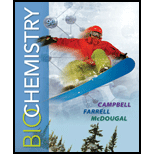
Concept explainers
RECALL Proteins,
Interpretation:
The basis for grouping substances such as lipids is to be defined.
Concept Introduction:
Proteins, carbohydrates and nucleic acids are the polymers of amino acid residues, sugar residues and nucleotides, respectively.
Saturated hydrocarbons contain only single-bonded carbon atoms, and unsaturated hydrocarbons contain multiple double or triple bonds.
Electronegativity is the property of an atom to pull electrons towards itself.
Answer to Problem 1RE
Solution:
Lipids are grouped only on the basis of solubility and non-polar nature of their molecules, whereas, some lipids do not share any structural similarity, like, groups if proteins, carbohydrates and nucleic acids.
Explanation of Solution
The amino acid residues are linked together by peptide bonds and polymerize to form a peptide chain, which eventually gives rise to a protein structure. The sugar molecules like glucose are linked together by glycosidic linkages to form a polymer of carbohydrate. DNA (deoxyribonucleic acid) is a polymer of deoxynucleotides, like, adenine, guanine, cytosine, and thymine. Carbohydrates have carbon, hydrogen, and oxygen in their structures. Proteins have amino and carboxyl groups in their structures. The nucleic acids have phosphate, sugar residue and a nitrogenous base in their structures. It suggests that all these molecules are grouped on the basis of some common groups or atoms that are constant in their structure.
The lipids are grouped on the basis of their hydrophobic nature, that is, the fear of water. The lipids are not soluble in water because of the presence of a hydrocarbon chain which is non-polar in nature. Polar molecules are those molecules that contain opposite charges on their molecules, for example, water. In water (
Lipids, sometimes, do not share a common structure. For example, the lipid compounds that carry long hydrophobic hydrocarbon chains and polar head groups are classified as fatty acids, sphingolipids, glycolipids, triacylglycerol, and others. The lipids that contain fused ring structures are grouped as steroids, and cholesterol is the most common type of steroid.
The lipids are grouped on the basis of solubility and non-polar nature. Also, some lipids are not structurally related.
Want to see more full solutions like this?
Chapter 8 Solutions
Owlv2,1 Term Printed Access Card For Campbell/farrell/mcdougal's Biochemistry, 9th
- Br Mg, ether 1. HCHO (formaldehyde) 2. H+, H₂O PCC 1. NH3, HCN ? (pyridinium chlorochromate) 2. H2O, HCI 11. Which one of the following compounds is the major organic product of the series of reactions shown above? Ph. Ph. OH NH2₂ A Ph. Ή NH2 B OH Ph Η Ph OH NH2 NH2₂ NH₂ C D Earrow_forwardB A 6. Which ONE of the labeled bonds in the tripeptide on the right is a peptide bond: H₂N N 'N' OH C H A, B, C, D or E? HN E OHarrow_forwardQuestions 8-9 are 0.4 points each. The next two questions relate to the peptide whose structure is shown here. To answer these questions, you should look at a table of H2N/.. amino acid structures. You don't have to memorize the structures of the amino acids. IZ 8. What is the N-terminal amino acid of this peptide? A) proline B) aspartic acid C) threonine 9. What is the C-terminal amino acid of this peptide? A) proline B) aspartic acid C) threonine N OH D) valine E) leucine D) valine E) leucine NH "OH OHarrow_forward
- 7. What is the correct name of the following tripeptide? A) Ile-Met-Ser B) Leu-Cys-Thr C) Val-Cys-Ser D) Ser-Cys-Leu E) Leu-Cys-Ser H₂N!!!!! N H ΖΙ .SH SF H IN OH OHarrow_forwardPlease draw out the following metabolic pathways: (Metabolic Map) Mitochondrion: TCA Cycle & GNG, Electron Transport, ATP Synthase, Lipolysis, Shuttle Systems Cytoplasm: Glycolysis & GNG, PPP (Pentose Phosphate Pathway), Glycogen, Lipogenesis, Transporters and Amino Acids Control: Cori/ Glc-Ala cycles, Insulin/Glucagon Reg, Local/Long Distance Regulation, Pools Used Correctlyarrow_forwardPlease help provide me an insight of what to draw for the following metabolic pathways: (Metabolic Map) Mitochondrion: TCA Cycle & GNG, Electron Transport, ATP Synthase, Lipolysis, Shuttle Systems Cytoplasm: Glycolysis & GNG, PPP (Pentose Phosphate Pathway), Glycogen, Lipogenesis, Transporters and Amino Acids Control: Cori/ Glc-Ala cycles, Insulin/Glucagon Reg, Local/Long Distance Regulation, Pools Used Correctlyarrow_forward
- f. The genetic code is given below, along with a short strand of template DNA. Write the protein segment that would form from this DNA. 5'-A-T-G-G-C-T-A-G-G-T-A-A-C-C-T-G-C-A-T-T-A-G-3' Table 4.5 The genetic code First Position Second Position (5' end) U C A G Third Position (3' end) Phe Ser Tyr Cys U Phe Ser Tyr Cys Leu Ser Stop Stop Leu Ser Stop Trp UCAG Leu Pro His Arg His Arg C Leu Pro Gln Arg Pro Leu Gin Arg Pro Leu Ser Asn Thr lle Ser Asn Thr lle Arg A Thr Lys UCAG UCAC G lle Arg Thr Lys Met Gly Asp Ala Val Gly Asp Ala Val Gly G Glu Ala UCAC Val Gly Glu Ala Val Note: This table identifies the amino acid encoded by each triplet. For example, the codon 5'-AUG-3' on mRNA specifies methionine, whereas CAU specifies histidine. UAA, UAG, and UGA are termination signals. AUG is part of the initiation signal, in addition to coding for internal methionine residues. Table 4.5 Biochemistry, Seventh Edition 2012 W. H. Freeman and Company B eviation: does it play abbreviation:arrow_forwardAnswer all of the questions please draw structures for major productarrow_forwardfor glycolysis and the citric acid cycle below, show where ATP, NADH and FADH are used or formed. Show on the diagram the points where at least three other metabolic pathways intersect with these two.arrow_forward
 BiochemistryBiochemistryISBN:9781305961135Author:Mary K. Campbell, Shawn O. Farrell, Owen M. McDougalPublisher:Cengage Learning
BiochemistryBiochemistryISBN:9781305961135Author:Mary K. Campbell, Shawn O. Farrell, Owen M. McDougalPublisher:Cengage Learning
